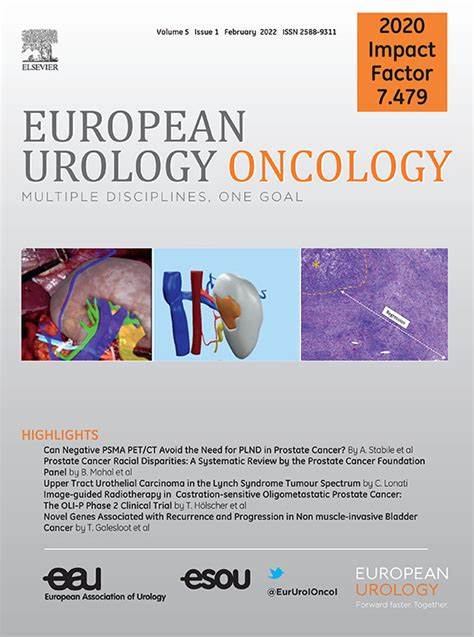比较低/中危膀胱癌患者标志物引导与膀胱镜监测的前瞻性随机尿路随访试验结果
IF 9.3
1区 医学
Q1 ONCOLOGY
引用次数: 0
摘要
背景和目的:越来越多的证据表明,目前非肌肉浸润性膀胱癌(NMIBC)患者的随访强度大大超过了临床需要。UroFollow试验研究了低/中危NMIBC患者与非劣效性护理标准(SOC)对照的标志物随访的诊断准确性(边缘:方法:Ta低危和高级别(G1-2) NMIBC患者随机分为SOC组或6个月的标志物随访组(算法包括尿液标志物和超声;基于标记物的监测方案[MA])。在3个月膀胱镜检查(白光膀胱镜检查[WLC])阴性后,只有算法阳性的患者在MA中进行WLC。对于无复发的患者,推荐在研究结束3年时进行WLC。同时,研究了几种新型尿液标志物。主要发现和局限性:共有214例患者被随机分为SOC组(n = 109)和MA组(n = 105)。中位随访时间为2.4年;SOC组肿瘤复发30例,MA组肿瘤复发29例。敏感性分别为96.5%和81.5% (p = 0.1),在SOC和MA患者中分别有1个和5个Ta低级别肿瘤被忽略。未遗漏肿瘤分期或分级进展。结论和临床意义:UroFollow是首个在低/中危NMIBC患者中进行的基于尿液标志物的随机试验。我们得出结论,在该队列中,3个月WLC阴性后6个月基于标志物的随访是安全的。然而,当代尿液标记物的结果表明,它们在基于标记物的监测中应用的潜力需要前瞻性的证实。本文章由计算机程序翻译,如有差异,请以英文原文为准。
Results of the Prospective Randomized UroFollow Trial Comparing Marker-guided Versus Cystoscopy-based Surveillance in Patients with Low/Intermediate-risk Bladder Cancer
Background and objective
A growing body of evidence suggests that the intensity of current follow-up in non–muscle-invasive bladder cancer (NMIBC) patients greatly exceeds clinical necessities. The UroFollow trial investigated the diagnostic accuracy of marker-based follow-up in patients with low/intermediate-risk NMIBC against the standard of care (SOC) for noninferiority (margin: <20%).
Methods
Patients with Ta low- and high-grade (G1–2) NMIBC were randomized to the SOC or 6-monthly marker-based follow-up (algorithm comprising urine markers and ultrasound; marker-based surveillance regimen [MA]). After a negative 3-mo cystoscopy (white light cystoscopy [WLC]), only patients with a positive algorithm underwent WLC in the MA. End-of-study WLC was recommended at 3 yr to recurrence-free patients. Simultaneously, several innovative urine markers were examined.
Key findings and limitations
In total, 214 patients were randomized to the SOC (n = 109) and MA (n = 105). The median follow-up was 2.4 yr; 30 and 29 cases of tumor recurrence were diagnosed in the SOC and MA arms, respectively. Sensitivity was 96.5% versus 81.5% (p = 0.1), with one and five Ta low-grade tumors being overlooked in the SOC and MA patients, respectively. No tumor progressing in stage or grade was missed. A total of 589 WLC procedures were performed in the SOC and 148 in the MA arm (p < 0.001). Among five other markers (ADX-Bladder, CellDetect, Bladder EpiCheck, UBC rapid, and Xpert bladder cancer monitor [BC-M]), Bladder EpiCheck and the Xpert BC-M showed similar performance to the algorithm.
Conclusions and clinical implications
UroFollow is the first urine marker–based randomized trial in low/intermediate-risk NMIBC patients. We conclude that 6-monthly marker-based follow-up after negative 3-mo WLC is safe in this cohort. Results of contemporary urine markers suggest that their potential for use in marker-based surveillance, however, requires prospective confirmation.
求助全文
通过发布文献求助,成功后即可免费获取论文全文。
去求助
来源期刊

European urology oncology
Multiple-
CiteScore
15.50
自引率
2.40%
发文量
128
审稿时长
20 days
期刊介绍:
Journal Name: European Urology Oncology
Affiliation: Official Journal of the European Association of Urology
Focus:
First official publication of the EAU fully devoted to the study of genitourinary malignancies
Aims to deliver high-quality research
Content:
Includes original articles, opinion piece editorials, and invited reviews
Covers clinical, basic, and translational research
Publication Frequency: Six times a year in electronic format
 求助内容:
求助内容: 应助结果提醒方式:
应助结果提醒方式:


